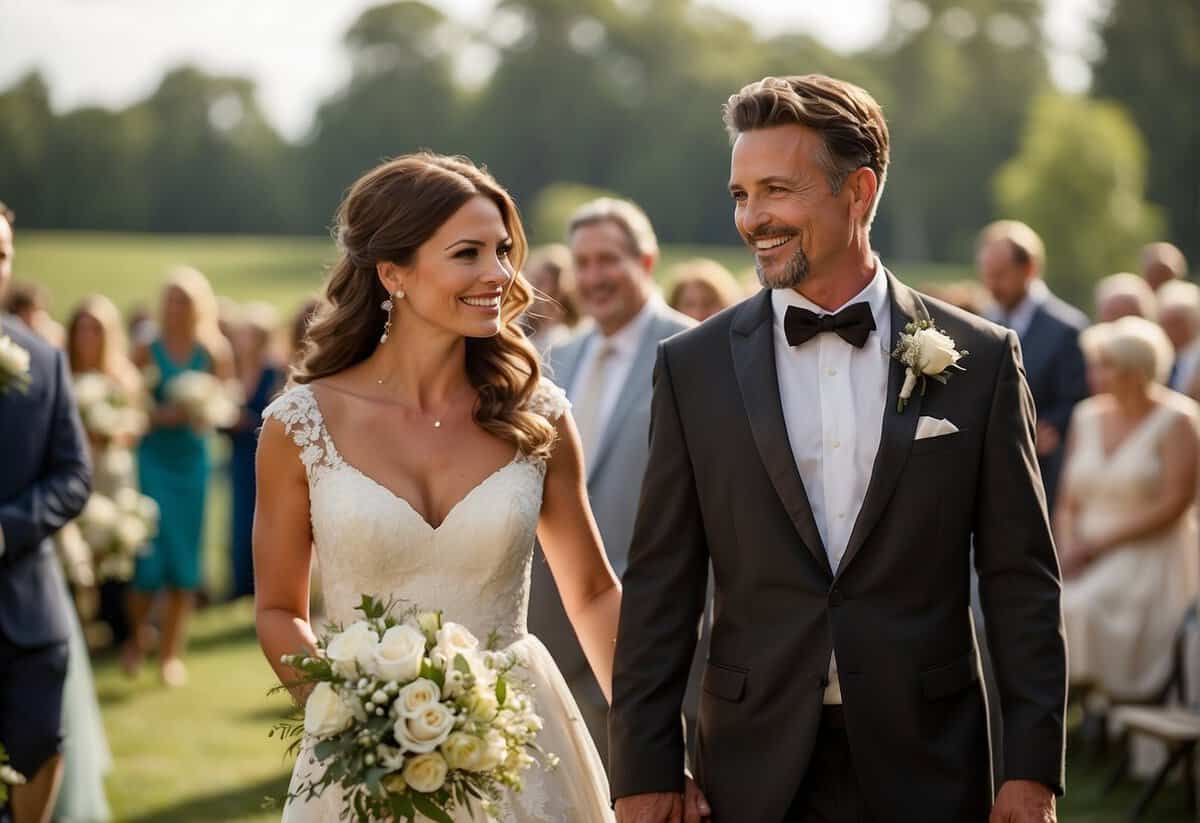What Is the Etiquette for Divorced Parents at a Wedding? Navigating the Celebration with Grace
Navigating the complexities of wedding etiquette with divorced parents can be a delicate matter, but thoughtful planning ensures everyone feels respected and included. Establishing clear communication early on about the roles each parent will play during the events can prevent misunderstandings and make the day more enjoyable for you and your family. Whether it’s deciding who gets top table privileges or managing the seating during the ceremony, the key is to handle these details with sensitivity and care.

At the reception, consider your divorced parents’ comfort levels with shared social situations to avoid unnecessary tension. It might involve arranging separate toasts or coordinating the order of parent dances to honor their contributions without forcing unwanted interactions. Remember that weddings are about celebrating your union, and that underlying family dynamics should take a backseat to your happiness on this special day. With tact and a pinch of diplomacy, you can create an atmosphere that accommodates the nuances of divorced family dynamics and allows all guests to enjoy the festivities.
Key Takeaways
- Begin with open, clear communication regarding each parent’s role and involvement.
- Manage ceremony and reception details to honor both parents without forcing interactions.
- Place the focus on celebrating the wedding while respectfully navigating family dynamics.
Pre-Wedding Communication and Planning

When planning a wedding with divorced parents, it’s crucial to establish clear communication from the start. This sets the foundation for a smoother, more comfortable event for everyone involved.
Importance of Open Dialogue
It’s important to have an open and honest conversation with each of your parents early in the planning process. Discuss your vision for the wedding and how you would like them to be involved. This can help prevent potential conflicts and set a tone of cooperation. Encourage amicable interaction and remind them that the celebration is about your happiness.
Managing Expectations and Comfort
Firstly, gauge each parent’s comfort level. You might find that one parent is open to collaborating, while another prefers to have separate roles. Be clear about your expectations for their involvement, respecting their boundaries and fostering a respectful environment. Here’s a simple way to lay out roles:
- Father: Ceremony usher, toast at reception
- Mother: Wedding dress shopping, reading during the ceremony
Part of managing expectations includes how to handle the topic of new partners. Have separate conversations with each parent about whether they’re planning to bring a date and how to best accommodate them in a way that won’t cause tension.
Navigating Invitations and New Partners
The invitation phase is delicate when it comes to families affected by divorce. Here’s what to consider:
- Send separate invitations to each parent to acknowledge their independence.
- Clearly state the name of the invitee to avoid assumptions about plus-ones.
When it comes to new partners, be diplomatic. If your parents have remarried or are dating, and it doesn’t cause discomfort for you, include their partners in the invitation. If you’re worried about potential discord, consider thoughtful seating arrangements that can help everyone feel at ease.
Ceremony Considerations

When your parents are divorced, navigating the ceremony details can be delicate, particularly concerning where everyone sits and how each parent participates. You’ll want to ensure that arrangements are clear and considerate to avoid any discomfort.
Seating Arrangements and Escorting
Your seating chart deserves thoughtful consideration to honor both of your parents while keeping the peace. Traditionally, both parents sit in the front row during the ceremony. To accommodate divorced parents and maintain a comfortable atmosphere, you might consider placing a relative or close friend between them for a buffer.
As for escorting, decide if you want to adhere to the tradition of walking down the aisle. If you prefer not to choose one parent over the other, you can have both parents escort you, or you may opt to walk alone or with stepparents in the equation.
Participation in Traditions
The role of your divorced parents in tradition comes down to what feels most comfortable for you and them. If your parents are amicable, they could both take part in rituals like lighting a unity candle. If that’s not the case, think about giving them separate roles that equally honor their presence at your wedding.
For traditions like the parent dances, you may choose to have a dance with each parent. It’s all about finding a balance that represents your relationships with respect and affection.
Reception Dynamics
Navigating the dynamics of a wedding reception with divorced parents requires tactful consideration to maintain a harmonious atmosphere. Factors like family introductions, seating arrangements, and inclusive traditions are all important for ensuring everyone feels respected and comfortable.

Family Introductions and Seating Plans
Your seating plan at the reception can significantly influence the mood and flow of the evening. For example, placing parents at different tables can prevent any discomfort, while ensuring they have an equal place of honor. When it comes to introductions, a clear and respectful announcement is key, such as “Please welcome the mother of the bride, Jane Smith” and separately, “Please welcome the father of the bride, John Doe.”
- Family Seating Chart Example:
- Table 1: Mother of the bride and her family
- Table 2: Father of the bride and his family
- Sweetheart Table: Just for you and your spouse
Remember to also consider where to seat new spouses if your parents have remarried, always aiming to keep the atmosphere positive.
Reception Rituals and Inclusive Celebrations
Including both parents in reception rituals can be a delicate balance, but there are ways to involve them without causing tension. For the father-daughter dance, some choose to split the dance between their father and stepfather or have separate dances to honor each relationship.
In terms of group activities like family photos, be upfront with your expectations. Communicate clearly with your wedding guests and the photographer about the order of photos to ensure a smooth transition between shots.
- Photo Order Example:
- Bride with mother
- Bride with father
- Combined family photos, if comfortable
Inclusive celebrations are about adapting the traditional rituals to fit the uniqueness of your family situation, ensuring that the reception is a joyful, stress-free celebration for everyone involved.
Post-Wedding Interaction

After the excitement of your wedding day, navigating post-wedding interactions with divorced parents requires careful consideration. Your wedding reception is a celebration, and maintaining a friendly atmosphere is key.
Behavior: Encourage your parents to display civil behavior towards one another. Gentle reminders that the day is about joy and family can help set the right tone.
Comfort: Prioritize the comfort of both parents by arranging separate, cozy spaces for each to socialize with guests, if needed.
Wedding Photos: When it’s time for wedding photos, communicate with your photographer ahead of time about the family dynamics. Plan for individual pictures with each parent to keep the situation tension-free.
Avoiding Drama: To preempt any family drama, assign a member of the wedding party or a trusted friend to be on the lookout and ready to defuse any potential emotional flare-ups.
Dealing With Emotions: Accept that emotions may run high, and there might be some tension, but everyone’s primary goal is to celebrate your union.
Remember, your wedding is about the happiness and love between you and your partner. With thoughtful planning, the post-wedding experience can be joyful and memorable for everyone involved, including your divorced parents.
Frequently Asked Questions

Navigating the nuances of wedding etiquette with divorced parents can seem complex. Rest assured, with a few guidelines, everyone can enjoy the special day comfortably.
How should divorced parents be seated at their child’s wedding reception?
You should aim for a seating arrangement that feels comfortable for all involved. Placing divorced parents at separate tables where they each can enjoy the company of friends or family often works well. It’s important to communicate beforehand to gauge their comfort levels.
What is the appropriate way for divorced parents to participate in wedding dances?
If your divorced parents are open to the idea, you can ask them about dancing together. However, they may prefer to dance separately, and if so, it’s respectful to allow each parent their own moment, perhaps with a special song chosen for each dance.
Where do step-parents sit during a wedding ceremony?
Step-parents typically sit in the front row, either next to their spouses or just behind the biological parents, depending on everyone’s comfort level. It’s a gesture that acknowledges their importance in your life.
What are some considerate ways to involve divorced parents in a small wedding?
In a small wedding, tailor their involvement based on their individual relationships with you. Options include reading a passage during the ceremony or being part of the processional. Regardless, ensure clear communication about roles to prevent any discomfort.
Who is traditionally responsible for wedding costs when the bride’s parents are divorced?
Traditionally, wedding costs are often shared, depending on the financial situation of each parent. It’s ideal to discuss and agree upon the contributions early in the planning process to avoid misunderstandings.
What is the proper etiquette for interactions between divorced parents at their child’s wedding?
Encourage polite and cordial interactions for the duration of the event. If tensions are high, it may be best to minimize direct contact by arranging separate spaces for them to socialize with the guests.
